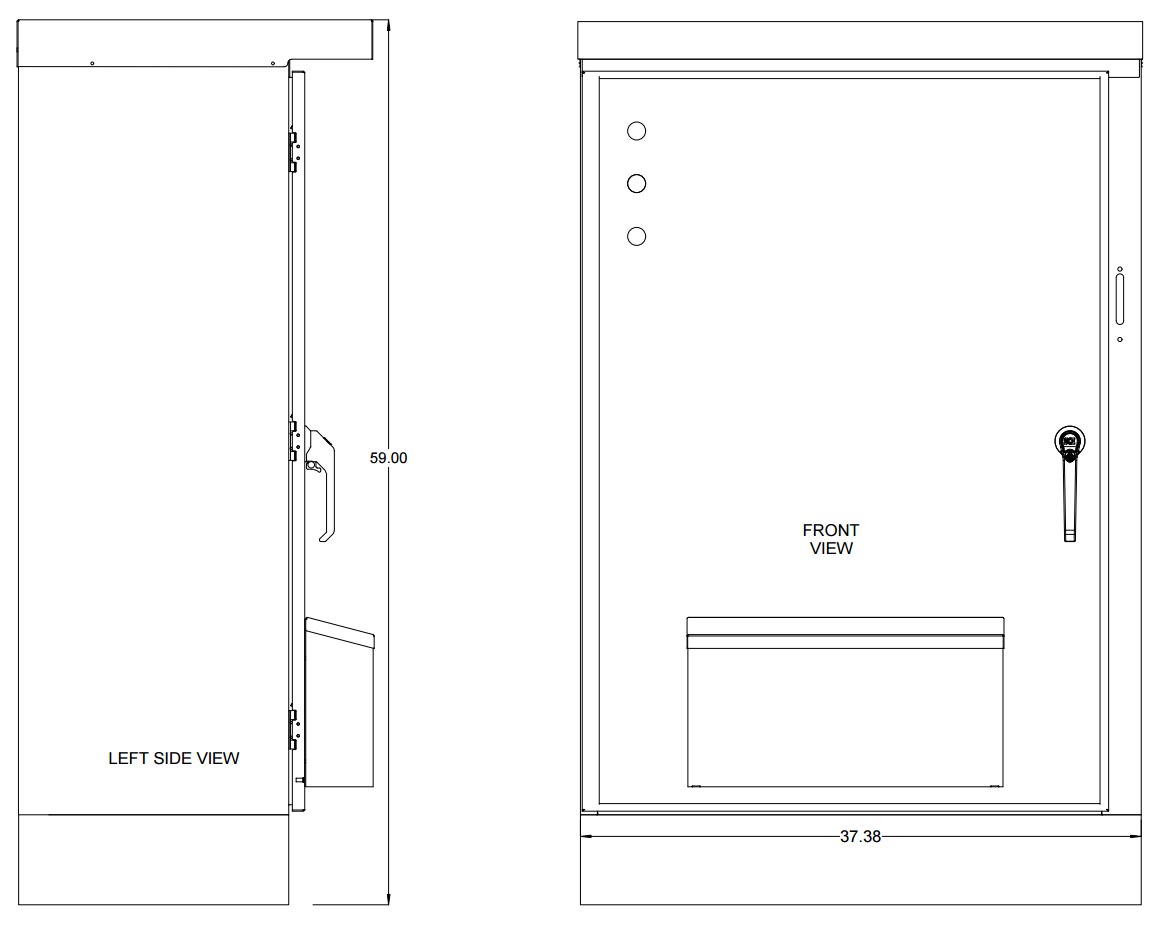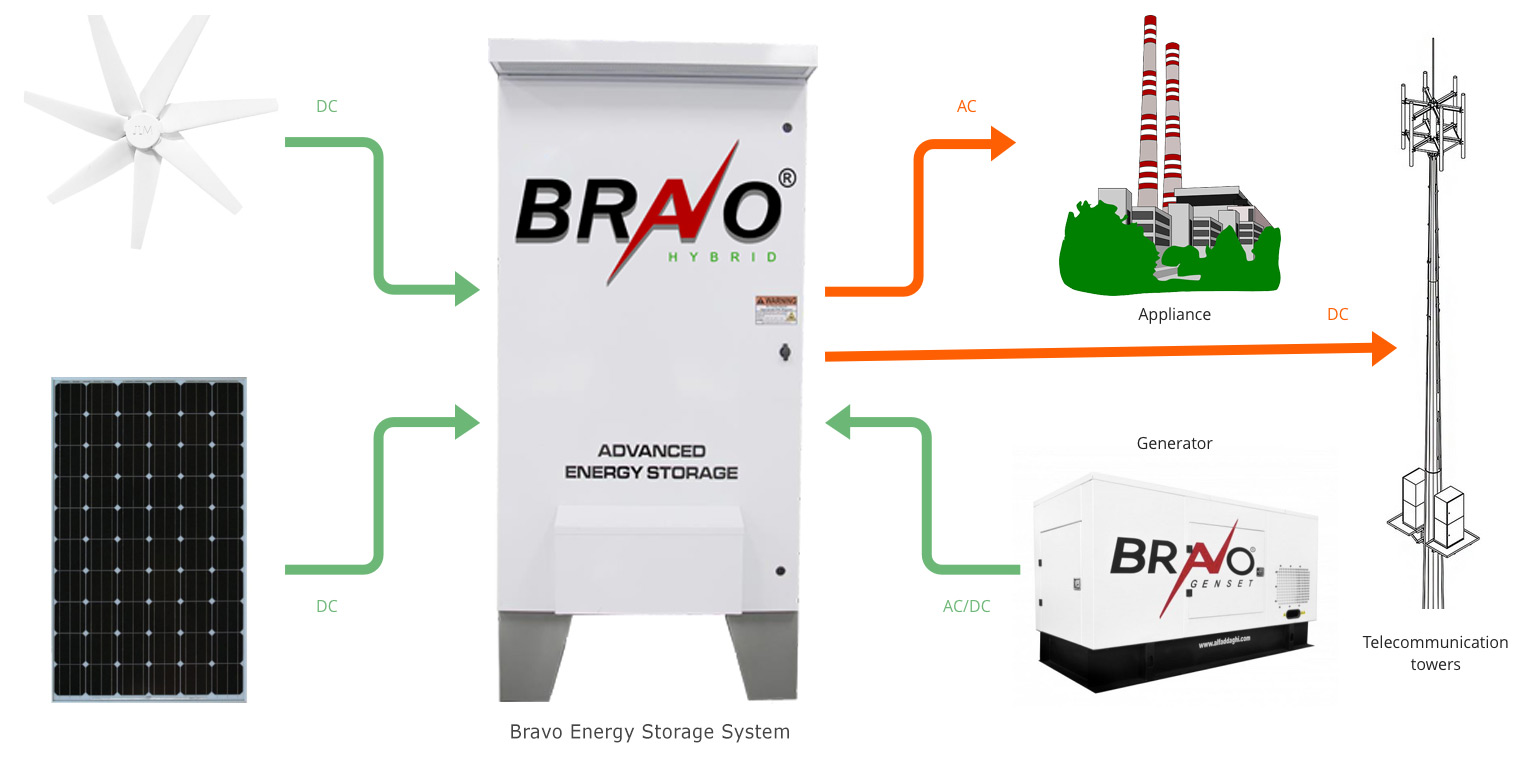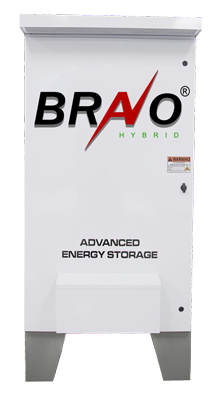Bravo Hybrid Systems
Hybrid Systems Bravo GHS-30-AS
Lithium Ion energy storage is a DC source, and as such needs a DC power electronics converter to control its rate of charge and discharge. The Bravo Energy Controller is a bidirectional buck/boost converter capable of precisely controlling Lithium Ion, PV, or any other DC source/load robustly, safely, and efficiently.
- Robust and Reliable
- Energy Storage Control
- Ethernet Communication
- High Efficiency DC
- Fast Response Time
Our Features
-
100kWRated Power
per Module -
50kWh*Storage
Capacity -
Lithium Ion(LiFeMnPO4)
Chemistry -
10 years(4000 cycles)
Lifetime -
EthernetNet
Communication
*Capacity can be scaled by adding more storage units
-
Call
-
Write
-
Come
-
Follow us
Specifications
General Specifications
Specification Min Nom Max Units
Rated Power Output 0 100 kW
Rated Output Voltage 290 584 V
Rated Output Current 0 350 A
Safety Listings and Certifications UL 1741 Pending
Controller Specifications
Specification Min Nom Max Units
Supply Power 100 W
Supply Voltage 24 V
Interface TCP/IP, CAN
Environmental Specifications
Specification Min Nom Max Units
Temperature 0 45 C
Cooling (provided) Forced Air Convection
Rated Max Elevation 6000 Ft
Enclosure Rating Type 3R
System Operation
Specification
Control Ethernet
Monitors Voltages, Currents
Safety Features DC Overvoltage, DC Undervoltage, DC Overcurrent, Overtemperature, Power Electronics Fault
Communication Ethernet, CAN

| Specification | Min | Nom | Max | Units |
|---|---|---|---|---|
| Rated Power Output | 0 | 100 | kW | |
| Rated Output Voltage | 290 | 584 | V | |
| Rated Output Current | 0 | 350 | A | |
| Safety Listings and Certifications | UL 1741 Pending | |||
| Specification | Min | Nom | Max | Units |
|---|---|---|---|---|
| Supply Power | 100 | W | ||
| Supply Voltage | 24 | V | ||
| Interface | TCP/IP, CAN | |||
| Specification | Min | Nom | Max | Units |
|---|---|---|---|---|
| Temperature | 0 | 45 | C | |
| Cooling (provided) | Forced Air Convection | |||
| Rated Max Elevation | 6000 | Ft | ||
| Enclosure Rating | Type 3R | |||
| Specification | |
|---|---|
| Control | Ethernet |
| Monitors | Voltages, Currents |
| Safety Features | DC Overvoltage, DC Undervoltage, DC Overcurrent, Overtemperature, Power Electronics Fault |
| Communication | Ethernet, CAN |

Description
The integration of renewable solar energy has increased stress on the power grid. By their very nature, photovoltaic (PV) energy sources fluctuate dramatically with weather. For example, the power output of a PV can drop by half in less than a minute due to clouds. The fluctuating power output from renewable sources cause line regulators, tap changers, and switched capacitors to switch much faster than before. They also contribute to transients, harmonics, and flicker in the power grid.
The GO Energy Storage System consists of an energy storage unit and a power control unit. The system provides clients with the ability to create custom power output profiles, optimize power usage, and provide renewable output smoothing. This is accomplished by charging the storage when excess power is generated and discharging the storage when diminished power is seen in the PV output. Custom power profiles can be also be programmed, after which the system would adjust its charge and discharge characteristics to meet the custom curve.

Demand Response Application Example
The GO system operates as an add-on to a system which includes an inverter and photovoltaic (PV) solar panels. The diagram below shows the GO system tied to the inverter and PV. The power control unit of the GO system is connected to the PV and the inverter. The PV generates DC power and supplies power to the inverter and the power control unit of the GO system.
Energy storage can be coupled with an existing photovoltaic (PV) system to greatly reduce power costs. While PV production is based solely on the weather, energy storage power can be controlled. Using energy storage to save energy during the sunny hours and deliver that same energy during peak cost hours can reduce electricity bills substantially. The system would monitors the user’s load, and if it begins to go above a certain peak threshold the energy storage would activate, serving some of the load, and reducing this peak, which in turn would result in lower peak demand charges.
Utility Application Example
The increasing integration of distributed renewable energy has increased stress on the power grid. By their very nature, photovoltaic (PV) energy fluctuates dramatically with weather. This fluctuating power output from these renewable sources can cause line regulators, tap changers, and switched capacitors to switch much faster than before. PV and inverter instabilities can also contribute to transients, harmonics, and instability in the distribution system. For example, if a PV string was generating 100 kW and a cloud passed over the array, this power could drop to under 50kW in less than 30 seconds. This can be very disruptive to the stability of the grid.
Adding energy storage to an existing PV system is one way to reduce these harmful effects. As can be seen above in figure 1, the Bravo Energy system can be added on to existing systems. The energy storage can buffer the output of the PV, reducing weather anomalies. The energy storage can also be used to level peaks in demand, create custom daily power outputs, and optimize the time at which the solar energy is sold for maximum profit.
-
Call
-
Write
-
Come
-
Follow us
